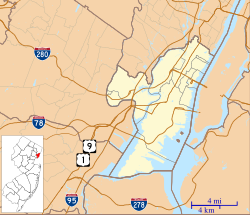New Jersey City University (NJCU) is a public university in Jersey City, New Jersey. Originally chartered in 1927, NJCU consists of the School of Business, College of Arts and Sciences, College of Education, and College of Professional Studies and is part of New Jersey's public system of higher education. In 2022, it announced that it was severely reducing its academic offerings due to a budgetary crisis.
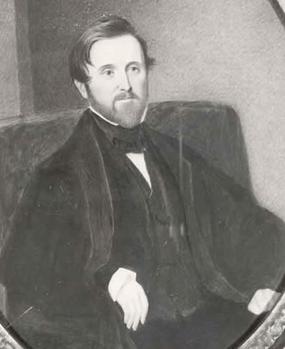
Alexander Jackson Davis was an American architect known particularly for his association with the Gothic Revival style.

Detlef Lienau was a German architect born in Holstein. He is credited with having introduced the French style to American building construction, notably the mansard roof and all its decorative flourishes. Trained at the École des Beaux-Arts, Paris, he designed virtually every type of Victorian structure—cottages, mansions, townhouses, apartment houses, hotels, tenements, banks, stores, churches, schools, libraries, offices, factories, railroad stations, and a museum. Lienau was recognized by clients and colleagues alike as one of the most creative and technically proficient architects of the period, and was one of the 29 founding members of the American Institute of Architects.
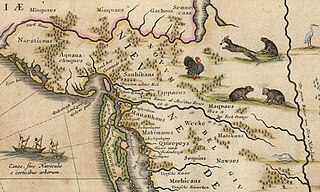
Bergen was a part of the 17th century province of New Netherland, in the area in northeastern New Jersey along the Hudson and Hackensack Rivers that would become contemporary Hudson and Bergen Counties. Though it only officially existed as an independent municipality from 1661, with the founding of a village at Bergen Square, Bergen began as a factory at Communipaw circa 1615 and was first settled in 1630 as Pavonia. These early settlements were along the banks of the North River across from New Amsterdam, under whose jurisdiction they fell.

The Van Wagenen House, also known as Apple Tree House, is located near Bergen Square in Jersey City, Hudson County, New Jersey, United States. The house was added to the National Register of Historic Places on August 16, 2006.

The Old Bergen Church is a historic church congregation in Jersey City, Hudson County, New Jersey, United States. Established in 1660 in what was then the Dutch colony of New Netherland, it is the oldest continuous religious congregation in what is today the State of New Jersey. The congregation is jointly affiliated with the Reformed Church in America and the Presbyterian Church (USA). The church was added to the National Register of Historic Places on August 14, 1973. The original church building was constructed in 1680 and the current edifice was built in 1841.

The Dr. William Barrow Mansion is located at 83 Wayne Street between Barrow Street and Jersey Avenue in Downtown Jersey City, Hudson County, New Jersey, United States. The mansion was added to the National Register of Historic Places on May 2, 1977, and is located within the Van Vorst Park Historic District, which itself was dedicated on March 5, 1980, and is roughly bounded by Railroad Avenue, and Henderson, Grand, Bright, and Monmouth Streets.

The Fairmount Apartments, also known as the Grand Lady of Jersey City, are located in Jersey City, Hudson County, New Jersey, United States. The Apartments were added to the National Register of Historic Places on March 3, 1995. The Apartments are an example of an early twentieth century Arts and Crafts style apartments. The building consists of two L-shaped 4+1⁄2-story brick-and-concrete structures connected by a 1-story structure.
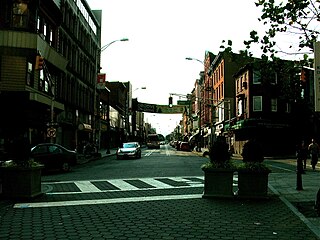
Harsimus is a neighborhood within Downtown Jersey City, Hudson County, in the U.S. state of New Jersey. The neighborhood stretches from the Harsimus Stem Embankment on the north to Christopher Columbus Drive on the south between Coles Street and Grove Street or more broadly, to Marin Boulevard. It borders the neighborhoods of Hamilton Park to the north, Van Vorst Park to the south, the Village to the west, and the Powerhouse Arts District to the east. Newark Avenue has traditionally been its main street. The name is from the Lenape, used by the Hackensack Indians who inhabited the region and could be translated as Crow's Marsh. From many years, the neighborhood was part of the "Horseshoe", a political delineation created by its position between the converging rail lines and political gerrymandering.
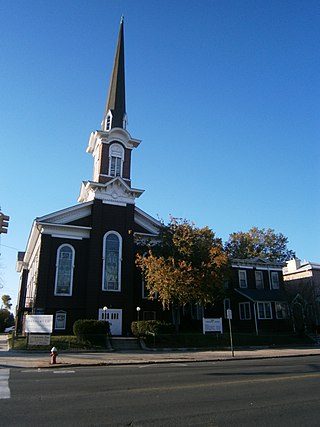
The First Reformed Dutch Church of Bergen Neck, now known as The First Federated Church of Bayonne is located in Bayonne, Hudson County, New Jersey, United States. The church was added to the National Register of Historic Places on April 22, 1982.

The Beacon is a mixed-use development located on a 14-acre (57,000 m2) site on Bergen Hill, a crest of the Hudson Palisades and one of the highest geographical points in Jersey City, Hudson County, in the U.S. state of New Jersey. The Beacon, which occupies the Jersey City Medical Center's rehabilitated original complex, creates the northeastern corner of the Bergen-Lafayette section and is just east of McGinley Square. The Beacon includes 2,000,000 square feet (190,000 m2) of residential and retail space, approximately 1,200 luxury residences and 80,000 square feet (7,400 m2) of retail space.

Van Vorst Park is a neighborhood in the Historic Downtown of Jersey City, Hudson County, New Jersey, centered on a park sharing the same name. The neighborhood is located west of Paulus Hook and Marin Boulevard, north of Grand Street, east of the Turnpike Extension, and south of The Village and Christopher Columbus Drive. Much of it is included in the Van Vorst Park Historical District.

The Jersey City YMCA, is located in Bergen Section of Jersey City, Hudson County, New Jersey, United States. The YMCA building was added to the National Register of Historic Places on November 12, 1999. The building is an example of an early twentieth century Renaissance Revival style. Built in 1923, in 1995 the building ceased to be used by the YMCA and was converted into affordable housing.

The West Side of Jersey City is an area made up of several diverse neighborhoods on either side of West Side Avenue, one of the city's main shopping streets. Parallel and west of Kennedy Boulevard, West Side Avenue carries two county route designations.

The Church of Our Lady of Grace is a Roman Catholic church built between 1874 and 1876. It is situated in Hoboken, Hudson County, New Jersey, United States. It is a Gothic-style church designed by Francis G. Himpler and William J. Whyte. Located on the corner of Fourth St. and Willow St. in Hoboken, it was listed on the National Register of Historic Places in 1996.

Hudson County, New Jersey has historic districts which have been designated as such on a municipal, state, or federal level, or combination therof. Some are listed on New Jersey Register of Historic Places and are included on National Register of Historic Places listings in Hudson County, New Jersey. The following is intended to be a list of places which encompasses an area or group of buildings or structures.

The Bergen Section of Jersey City, New Jersey is the neighborhood on either side of Kennedy Boulevard between Saint Peter's College/ McGinley Square and Communipaw Avenue in the Bergen-Lafayette section of the city. The name Bergen, used throughout Hudson County, is taken from the original Bergen, New Netherland settlement at Bergen Square.

The Newkirk House, also known as the Summit House, located at 510 Summit Avenue is the oldest surviving structure in Jersey City, New Jersey. The two-story Dutch Colonial building, composed of sandstone, brick, and clapboard dates to 1690.

The Jersey City Free Public Library (JCFPL) is the municipal library system of Jersey City, New Jersey, serving the residents of Hudson County. The library was established in 1889, opened in 1891, and had its first dedicated building, the main library, by 1901. Numerous branches have since opened and as of 2023 there are nine throughout the city as well as a bookmobile. It has over a million physical and digital items its collection, making it the largest library system in the state.

